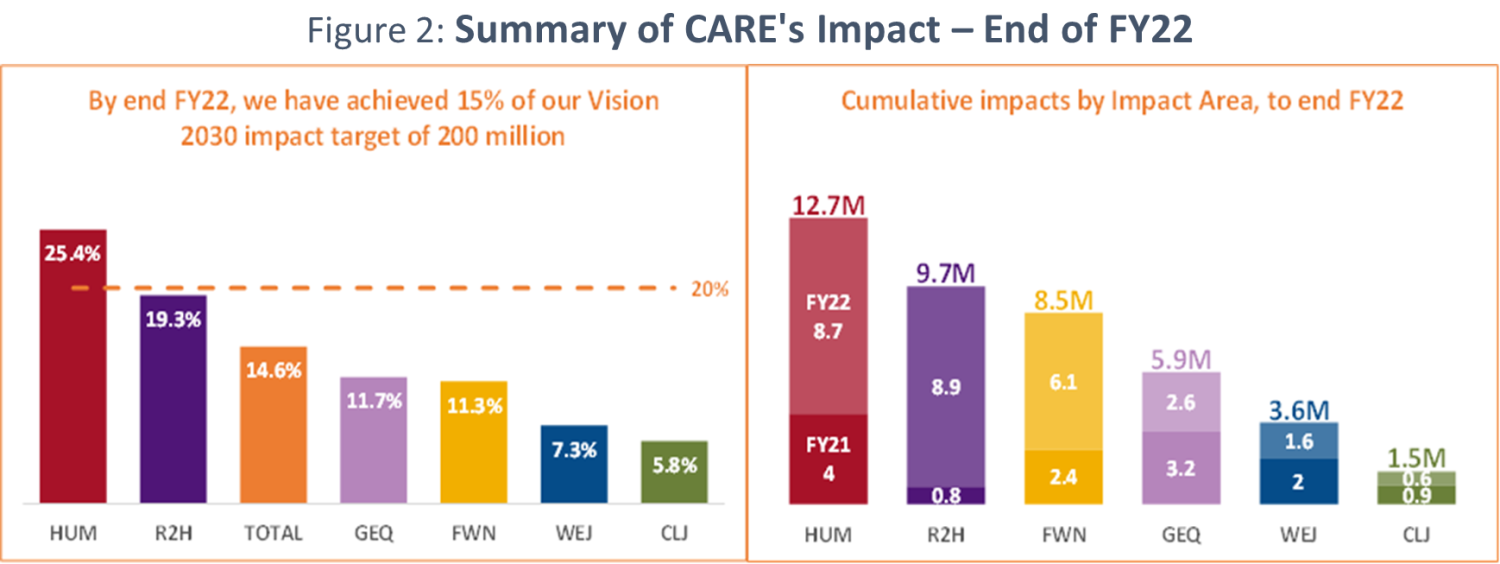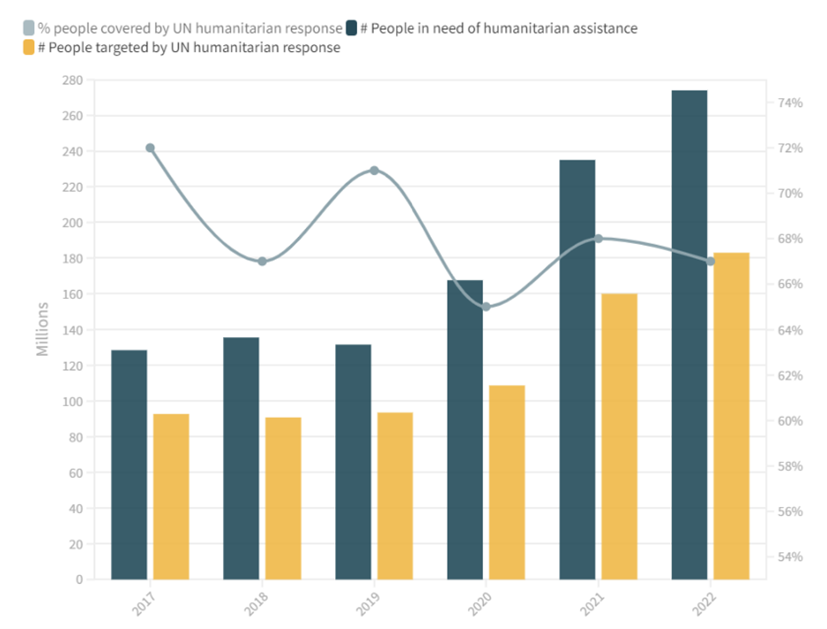Driven By Impact: Using Impact Data to Pivot Global Strategy
CARE International approved Vision 2030 in June 2020. In 2023, we took stock of the impact we have achieved after 2 years and the actions we need to take to deepen and strengthen that impact.
CARE’s impact data shows that more than 29.1M lives have been positively impacted by our work. This is a cause for celebration of the hard work of CARE and our partners. We are singularly placed amongst our peers to be able to measure our impact and report against the Sustainable Development Goals.
Vision 2030 was developed in a very different world. Since it was approved, we have experienced a global pandemic, increased conflict, and heightened consequences of climate change all of which have resulted in a huge increase in humanitarian need – increased hunger and food insecurity and deep economic crises affecting the poorest and particularly women and girls most. We have seen an increase in poverty and social injustice[1]. That our programs have demonstrated positive impact during this period is impressive.

Figure 2: Summary of CARE's Impact – End of FY22
Progress is inconsistent. Our analysis indicates that this is due to the complexity of the contexts in which we work, our ability to consistently scale impact through addressing the deeper structural causes of poverty, as well as our ability to measure and validate impact. We seek to positively impact the contexts, increase our impact, and improve our ability to measure it over time.
Summary Analysis of CARE’s Progress – 2 years into V2030[2]
Summary Analysis
- We are on track to achieve our impact over V2030.
- We have not adequately balanced the time we spend collecting and validating data, and time learning and making decisions based on the data.
- Projects have challenges adopting the indicators (training, resources, capacity to measure) or don’t report on indicators that are similar.
- Across all impact areas (IAs) and in the context of gender equality impact, most of our impact is on building agency. There is very little reported impact on changing relations and transforming structures.
- At present there is a large concentration of impact in a small number of countries or programmes, we need to understand this better.
- The pandemic still affects impact. Additional global challenges (hunger and worsening economic insecurity) have repercussions on our ability to contribute to more and lasting change.
Summary Actions
- Ensure we measure high-impact work that is ongoing, including sustainably scaling solutions, advocacy, and systems-level work.
- Improve guidance to measure IA and Pathways indicators and provide training, mentoring and Technical Assistance (TA) to more Project teams on how to measure impact.
- Pay increased attention to deliberately programming for and measuring change through our gender indicators.
- Perform quarterly validation of impact data .
- Do more sensemaking of the data, particularly exploring the connection between impact, gender, scaling pathways, and partnership because this will enable us to understand if the assumptions inherent in Vision 2030 are borne out to greater impact.
- Reassess progress towards 2030 goals after FY23 data is reported and use this review of programme goals in V2030.
Vision 2030 and the Changing World
V2030 lays out our intent to go beyond direct project level outputs (e.g. training teachers) to address deep relational and structural change in the broader system in order to achieve impact at scale and ensure that no one is left behind. This means, for example, identifying and addressing the underlying causes that keep girls out of school so all girls can access school and get high quality education. To do this, CARE must work with others locally in any given context.
It also means we need to act to influence global systems – the connection between our local and global work is critical. This is particularly important post-COVID where we saw the result of a poor health system globally (that meant some countries were able to stockpile vaccines, while others had none), where we are experiencing an economic crisis affecting the poorest most (e.g. in Sri Lanka and Latin America) and more recently where we have seen the conflict in Ukraine have direct consequences on food security across the globe. The result has been a massive, heart-breaking increase in humanitarian need, which is going unmet.

Figure 3: Source: LSE UK 2022
CARE’s data indicates an increase in programming to respond to COVID-19 and to humanitarian need more broadly. In fact, most of the impact we have seen in the first two years of V2030 is in health and humanitarian programming. While the context and our mandate require us to respond to humanitarian need; moving forward, it is critical that both our humanitarian and development work seek to address the broken systems that are failing to serve people in the long term – and particularly the most marginalised. We need to be deliberately working across the nexus between humanitarian and development work to address increasing needs in the growing number of fragile contexts, and we need to advocate to donors that this is crucial and non-negotiable; we need to strengthen local systems and partners to respond to emergencies by preparing ahead, and we need to focus on gender equality – as women and girls are the most acutely affected by poverty and humanitarian crises.
[1] https://blogs.worldbank.org/developmenttalk/covid-19-leaves-legacy-rising-poverty-and-widening-inequality
[2] In Annex 1, a more detailed analysis by impact goal highlights analysis by impact area (left hand column) and recommended actions to address concerns/gaps (right hand column).



